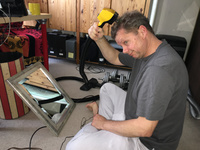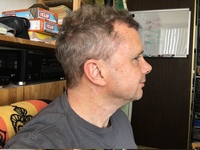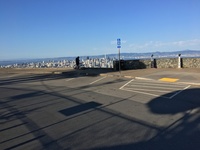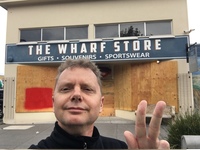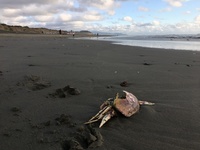 |
| Angelika/Mike Schilli |
Michael It will probably be a while before our strict governor lets us go to the hairdresser again, but our hair is unimpressed by this and continues to grow like crazy. My last visit to the hairdresser was over three months ago, and I usually go to my regular barber once a month, so quick action was needed. I inquired at work about solutions, and the jokers there recommended the so-called "Flowbee," a system from the last century that every middle-aged American probably knows from the TV commercials of their youth.
It is a cutting device at the end of a long hose that you connect to a vacuum cleaner. The vacuum cleaner sucks on the hair through the hose, and the cutting mechanism trims the ends all to the same length. The exorbitant price of $145 only deterred me briefly, but then I thought to myself, I absolutely have to include this in the newsletter, and clicked the "Buy" button. At the same time, I ordered a professional hair clipper, the "Wahl Pilot Clipper #8483," and after watching some YouTube videos, I was confident that I could trim my hair neatly.
First, I trimmed the sides with the trimmer as described in the YouTube videos, but I had trouble coordinating the movements of a pair of scissors in the mirror when it came to the top hair on the crown, which needs to be left longer; otherwise, it looks impossible and like a mullet. Quickly, I grabbed the Flowbee, selected an attachment about 2.5 cm long, turned on the vacuum cleaner and the Flowbee cutting device, and tapped it all over the top of my head. In no time, the Flowbee sucked in the hair with each contact and cut it precisely to the same length. It was so effortless, I barely noticed that anything was being cut at all. There's no mess either, because the vacuum cleaner immediately sucks up all the cut hair. Top product!
Newsletter reader Conny has pointed out to us, by the way, that a clone of the Flowbee device already appeared in the 1992 film Wayne's World. It appeared as a parody of the Flowbee system, which was apparently being heavily advertised on American television at the time. In a funny scene, Garth gets an obviously painful haircut from an industry representative. However, the real Flowbee is actually very gentle; as mentioned, you don't even notice that anything is happening, but afterward, the hair is definitely shorter than before and all exactly the same length.
The result, after about half an hour of work with both devices, is quite impressive, I think (see Figure 5). When I come home from the hairdresser, I look somewhat similar, as my hair tends to be a bit unruly. Following this initial success, I also trimmed Angelika's short haircut with the trimmer and even gave her the professional coloring she had ordered from her regular hairdresser via contactless delivery. Although it was a tough job that took over an hour, the result was really satisfactory (see Figure 6). Conclusion: Professional service workers also put their pants on one leg at a time. With some practice, amateurs can achieve similar results.
Angelika How many times have we thought, while vacationing in some beautiful city, that we could stay there for a year and still not see everything? We felt that way in Tokyo back then, and of course in New York as well. Until now, we actually thought we knew San Francisco like the back of our hand, since we've been living here for over 20 years and we don't just sit on the couch on weekends, but often set out to explore our city. However, you surely know that such a habit often draws you back to your favorite spots. Certain areas are also actively avoided by locals in San Francisco because they are so overrun by tourists that you can't set foot in there during normal times.
However, everything is different at the moment because the coronavirus pandemic and travel restrictions have driven tourists away from the cityscape. Thus, on our daily evening walks, we are rediscovering corners where we would normally leave to the tourists. Recently, we strolled in the soft evening light around the exterior grounds of the venerable "Palace of Fine Arts" building, which was constructed in 1915 for the Panama-Pacific Exposition, and we had the building almost to ourselves. On another evening, we hiked through the Presidio Park to Marshall's Beach, over many hidden wooden stairs in the dune and cliff landscape. We were rewarded with a fantastic view of the Golden Gate Bridge and the Pacific Ocean, as Marshall's Beach is located in close proximity to the bridge.
Since San Francisco is very hilly and surrounded by water, there are always those moments of breathtaking beauty when the city lies at your feet from high above. The sky is often so blue these days, as if a child had painted it in a picture book. This is, of course, also due to the reduced air pollution from fewer cars and airplanes. We are falling in love with our city all over again, as extremely high rents and living costs, dirty and crowded streets, and construction sins had somewhat tarnished our old love.
It is truly amazing how far one can travel on foot. The book "Stairway Walks in San Francisco" particularly helps us discover new corners again and again. It describes routes in San Francisco that incorporate all kinds of stairways. Due to the hills, San Francisco has many such connections. Often, you can't go any further by car, but stairs lead pedestrians from top to bottom or vice versa. San Francisco counts over 600 such stairways. There are large, long stairs, open and hidden ones. The hidden ones are often surrounded by beautiful, enchanted gardens.
The book "Stairway Walks in San Francisco", written by Adah Bakalinsky, has actually been known to us since our early years in San Francisco. When we moved here, we took one or two routes from the book, often with visitors in tow. In the meantime, the book has been revised and supplemented several times with the support of Adah's friend Mary Burk. We are now close to having walked all the described routes at least once. But we can also proudly say that for almost 10 weeks now, since San Francisco has been in a state of emergency, we have gone out every evening after work (with only three exceptions).
In addition to the stairways, we are always drawn to "Ocean Beach" right within city limits. Unlike other beaches in the surrounding area, our mayor had mercy and did not close off the beach. The parking lots directly at the beach are closed, supposedly to curb the influx of beachgoers from outside, but we always find a parking spot in the side streets. Also, the Great Highway, which runs parallel to the beach, is partially closed, allowing cyclists and pedestrians to use this section of the road undisturbed. The beach is very wide, especially at low tide, so walkers don't get in each other's way. Since it is usually not warm enough for sunbathing and the water is too cold for swimming in the waves, we never see scenes of sunbathers lying close together on their beach towels at Ocean Beach. For me, there is nothing more relaxing than letting the wind blow around my ears and inhaling the salty air during a beach walk. The best therapy against the strains of the pandemic.
Michael The waiting in front of grocery stores is the most nerve-wracking aspect of the crisis. It's not uncommon to see 20 or 30 people standing in front of the store door, all spaced 6 feet (and often more) apart from each other, with the line stretching around the next street corner. In front of some stores, you can even see two separate lines extending in different directions: one for regular shoppers and one for so-called "Instacarters".
The latter are drudges of the company "Instacart," who shop for people who select groceries online using the "Instacart" app and then have them delivered to their door. The actual shopping is done by low-wage workers who run around the store recklessly, stare at their smartphones, and have no idea which shelf the requested products are on. After customer complaints, the stores assigned the Instacarters their own queue, and when a customer left the store, one person from alternating queues was allowed to enter. Then some stores limited the number of Instacarters in the store, and only when an Instacarter left the store was a new one from the Instacarter queue allowed in; otherwise, only regular customers were let in.
Now it is incredibly annoying to drive to a store only to see that the line is hopelessly long again, so some tech-savvy individuals set out to create a website as a remedy. In the https://storequeue.com, customers themselves can report how long the waiting time in front of a specific store actually is. The website displays all known grocery stores within an adjustable radius and the most recently reported waiting time. If you are standing in front of a store and the waiting time is accurate, you can report this by tapping the "Like" symbol. If it is not accurate, you can give a "Thumbs down" and enter how long you actually waited.
The whole thing only works, of course, if many people participate. It seems to be working well because recently, around noon, I saw that according to Storequeue, the waiting time in front of our otherwise totally overcrowded Trader Joe's was only 10 minutes. I immediately ran downstairs, got in the car, and drove there. I could hardly believe it, but there were really only three people in front of the entrance, and within five minutes I was inside. Out of shock, I made a few panic buys. I'm loving this top product!
Angelika Flour and yeast are still scarce in the supermarkets here. Apparently, a large portion of the population has discovered home baking. Bread baking, in particular, seems to be very trendy right now. Amusingly, during one of our evening walks around the city, we discovered some dough remnants sealed in plastic bags, which someone had nailed to a telephone pole along with instructions. Upon closer inspection, it turned out to be a sourdough starter for bread baking. According to the instructions, it needed to be fed every day with a quarter cup of flour and 2 tablespoons of water.
The instructions were somewhat lacking for me, but I have also never baked bread myself. We also didn't take the sourdough culture with us, which in hindsight was a wise decision. I had a feeling that something requiring daily care would be too much effort for my taste. When I consulted the Internet on how to make sourdough bread, all the entries promised how super easy it would be, but the time factor and the extra kitchen utensils needed, like a proofing basket, were just not for me. I already have enough to do keeping my students in check via video conferences at the moment.
Michael As you know, nothing annoys me more than standing in line for trivial things. Dinner at the trendy restaurant where people wait for hours for a table? Happens without me. Shopping on Sunday afternoon when Americans trample on each other in supermarkets? No way, I only show up 15 minutes before closing time, it's quicker then. Now you can surely imagine how thrilled I was with the absurd government regulations during the coronavirus crisis. Long lines formed in front of every supermarket like in the worst state-run mismanagement, and instead of buying Pellegrino once a month at our mega supermarket Costco, I had to look for new sources of sparkling water.
Now, tap water in America's big cities is heavily chlorinated, and that's why we've only used it for cooking so far. But just in time before the supply disruptions, I had ordered a Brita filter jug and a Sodastream sparkling water machine from Amazon. The activated carbon in the filter removes the chlorine from the water, supposedly also other contaminants, and after pressing the button on the sparkling water machine twice, we have pristine mineral water in glass bottles on the table. I was surprised at how good it tasted, and I'm not sure if we'll ever go back to Pellegrino.
Now the Sodastream crooks are making absurdly high profits with the carbon dioxide (CO2) bottles that need to be exchanged every month. The cartridges with 350g of CO2 for making sparkling water cost a whopping 30 dollars, and you get 15 dollars back as a deposit, but only if you buy more expensive CO2 from the Sodastream crooks; otherwise, the deposit is irretrievably lost. Obviously, this is a total rip-off, because a kilo of CO2 costs only about 2 dollars, which is something to think about! So, if you buy your CO2 for sparkling water as "Beverage Grade CO2" from a welding supply store, you pay only about 60 cents for the amount in a Sodastream rip-off cartridge instead of $30.
On YouTube, there are now numerous videos circulating on how to connect the bubble machine with its proprietory connector to regular CO2 gas cylinders from the welding shop, and Amazon already offers Hoses and Adapters for this purpose.
I ordered the hose right away despite the horrendous price of $90, even though you could probably build something similar for $20 with parts from the hardware store, but when it comes to pressurized gas, I'm rather conservative. Unfortunately, due to COVID, we are currently experiencing the added difficulty of a global CO2 shortage. The welding supply store in San Francisco is currently only selling to regular customers. But this too shall pass, and the CO2 will flow again, just wait and see!
Angelika Anyone who works with young children or has their own children knows the classic "We're Going on a Bear Hunt" by Michael Rosen. I can't even count how many times I've reenacted this picture book story with children, crawling through the tall grass, stomping in the mud, and swimming through the river together, only to finally arrive at the bear's cave. Shortly after the lockdown restrictions were imposed, we started seeing teddy bears placed in windows during our walks.
At first, we thought that children had just placed their stuffed animals in the windows for no particular reason, but it soon became clear that there was more to it -- essentially a pandemic game. The rules are simple: the task is to find as many teddy bears in neighborhood windows as possible. It's a good way to keep children entertained during the permitted outdoor walks. To be honest, we also enjoy it, and we're always happy when we spot another bear.
Besides the bears, many people are also giving free rein to their artistic ambitions, hanging signs with encouraging messages in their windows or on their balconies. Our neighborhood is full of them: "Let the Distance Keep Us Together" beamed at us from a balcony. Some also thank the medical staff or other workers who are doing a lot during this crisis. On another side street near us, a resident has decorated the sidewalk with large plastic flamingos that smile at you cheerfully and spread good vibes.
The idea, of course, had to be put to educational use right away and shared with my students. I recorded a video of the signs during our walks, added my commentary to the video, showed it to my students, and then had them create similar signs and display them visibly in their windows.
Michael Although I am not a master tailor, I am a proud owner of a sewing machine, can install the upper and lower threads, and sew simple patterns. Since supermarkets in San Francisco now require customers to wear masks, I reluctantly set about sewing two masks from leftover fabric with a sushi motif, which I had used to upholster our dining chairs.
A really simple guide onYouTube Here is the translation to English:
Following a simple guide on YouTube, I managed to create two not only perfectly fitting but also elegantly shaped masks with elastic bands for strapping on, within less than an hour.
Whether the masking helps at all, I still doubt, because you actually have to wash and dry the masks after each use, and you must not touch your face with your fingers when putting them on or taking them off. No idea if it does any good at all, but rules are rules, as we know, and there's no getting around that, and you have to go shopping at some point.
Angelika While you guys in Germany can already look forward to easing restrictions, things are not really progressing here. Far too few people are still being tested for Corona in the USA, and even in California. No one really knows how many people are actually infected here. A look at the statistics reveals that officially 2,131 people in San Francisco (as of May 18, 2020) have been infected with the coronavirus. That makes it well under 1 percent of the 881,549 residents! However, the number of unreported cases could be enormously high.
Therefore, almost everything remains shut down here. What has been added to the list of open businesses such as grocery stores, farmers' markets, medical practices, hospitals, pharmacies, drugstores, banks, the post office, laundromats, gas stations, auto repair shops, and hardware stores that we mentioned in our last newsletter? Honestly, almost nothing. Only golf and tennis courts, as well as garden centers, were allowed to reopen under certain conditions on May 5th in San Francisco. And construction sites are allowed to resume work. My dentist is open but is currently only treating emergency patients. Other medical practices are just starting to slowly allow routine visits again. Until now, this was either done via video conference or the appointment was repeatedly postponed.
Restaurant owners in San Francisco are still trying to stay afloat with take-out service. When they will be allowed to serve guests at tables again is still up in the air. However, starting today (May 18), Phase 2 of business reopenings has begun in San Francisco. It is somewhat unclear how exactly this will proceed. Customers are still not allowed to enter the stores; instead, goods must be picked up at the curbside. Logically, the store would need a proper website where customers can select their goods. However, many small stores do not have their entire inventory online or are not set up for online orders at all. Orders via phone or email would theoretically be possible if customers know what they want. I am curious to see how this will work out, as customers visit smaller stores precisely because they want to choose something on-site. We will report in the next newsletter on how things have settled. By the way, the regulations here are sometimes just as confusing as in Germany, because while our Governor Newsom sets the guidelines for the whole of California, individual counties and cities can impose their own stricter regulations.
Schools, however, are closed throughout California until after the summer holidays. When this was announced, we educators at my school were a bit taken aback, because distance learning sometimes frays the nerves of us, the parents, and the children. That's why I can only laugh when politicians boast that schools need to focus more on digital learning. Most of my students love everything to do with computers, but they want nothing more than to sit in the classroom with their schoolmates again. School conveys more than just learning content and is immensely important for social development. Anyone who has ever tried to get eight- or nine-year-olds to work independently, which digital learning requires, knows what I'm talking about. Many students still have difficulties with it.
Naively, I also thought that I'd have time to look into administrative tasks during work hours now. Far from it. I actually spend the whole day in video conferences with students and parents or in email contact to help, calm, and motivate. Honestly, I have more to do than usual. I also teach my social-emotional learning class live via Zoom almost every day. By now, I am quite skilled at designing games that we can play over video conference.
Angelika Anyone who has known me for a long time knows that I am not exactly an enthusiastic sports fanatic. In school, I always had the worst grades in physical education, which didn't really bother me because I preferred being good in English and bad in sports rather than the other way around! However, I often suffered a lot in gym class and had many rather clueless gym teachers who didn't understand why it made me shudder and scared to jump over a vaulting horse. Nowadays, I enjoy being active, especially outdoors: hiking, swimming in the ocean, biking, boogie boarding in Hawaii; I'm in. There is a widespread belief that the USA is only made up of overweight people who lounge around on the couch, shoveling potato chips and popcorn into themselves. Of course, as always, this is a bit of an oversimplification. For many Americans, exercise and sports are also important.
And of course, there are also those who overdo it and spend the entire day figuring out how to optimize their bodies. A visit to the beach in Los Angeles reveals many such specimen who not only constantly train their muscles but also feel the need to show off their well-toned bodies, whether their fellow humans want to see it or not. I am generally suspicious of anything that comes across as extreme: extreme political views as well as health fanatics. My motto is more: everything in moderation. So far, I have had the impression that San Franciscans like to be outdoors but are not completely crazy when it comes to physical exercise. However, the coronavirus crisis has unfortunately led to another epidemic in San Francisco. Since yoga and fitness studios are closed, joggers are now clogging the streets, just like cars used to.
Based on my observations, joggers can be divided into three categories: those who have always enjoyed jogging, those who have never run in their lives and have now started jogging during the crisis —- usually noticeable by their completely exhausted, red-faced appearance as they trot by, making you fear they might collapse at any moment—and then those who can't live without jogging and sprint through the landscape like maniacs, without any regard for others.
I'm currently not very fond of the latter category. As is well known, people don't have eyes in the back of their heads, which also applies to pedestrians on sidewalks. Some of these joggers, who sprint around at breakneck speed in a straight line, seem to have forgotten this important fact. It has happened to me several times that these joggers came so close to me that I could feel their breath on my back before they rushed past me, even though there was plenty of space to move aside. Apparently, it is too much to ask for them to deviate from their straight line and run a bit of a slalom. I couldn't even protest loudly, because this type of jogger usually has earplugs in, listening to music while running.
Now, to be honest, I don't really know what danger of infection these joggers pose. I think what bothers me more is the inconsiderateness of some people, but that was already the case before the coronavirus crisis. Fortunately, the majority of people we encounter on our daily walks keep their distance, or they step aside, or sometimes even say thank you when we make room for them. Michael is more relaxed about it than I am anyway. My theory is that in the current crisis, people's personal risk tolerance greatly influences their behavior.
Lately, I keep thinking about a fascinating lecture in the field of psychology at the castle in Münster from the time before my special education studies. The fact that I still remember the content of the lecture after decades is astonishing and shows how interesting I found the material. Professor Ulrich Tränkle, a leading traffic psychologist, explained to us the psychology of risk perception and how it affects decision-making. People do not necessarily assess risks objectively, but subjectively, and this subjective perception often leads to poor decisions. I wonder what the good Mr. Tränkle would say about the current coronavirus measures? Unfortunately, he passed away in 1995 and can no longer contribute to the discussion.
Best regards from Saint Frankstadt!
Angelika and Michael


